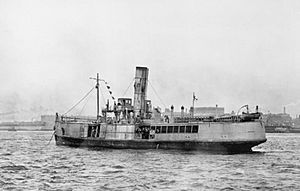SS Royal Iris facts for kids

Iris returns to Liverpool after the Zeebrugge Raid
|
|
Quick facts for kids History |
|
|---|---|
| Name |
|
| Owner |
|
| Builder | Robert Stephenson and Company, Newcastle upon Tyne |
| Launched | 1906 |
| Christened |
|
| Identification | UK Official Number 123971 |
| Fate | Scrapped 1961 |
| General characteristics | |
| Tonnage | 491 gross register tons (GRT) |
| Length | 159 ft (48 m) |
| Draught | 8 ft 6 in (2.59 m) |
| Propulsion | Steam engine, 2 shafts |
| Capacity | 1,735 passengers |
The SS Royal Iris was a famous ferryboat that sailed on the River Mersey in England. She was built in 1906 for Wallasey Corporation and was first named Iris. In 1918, during World War I, the Royal Navy took her over for a very brave mission called the Zeebrugge Raid. After this mission, she was renamed Royal Iris to honor her courage. She went back to being a ferry, was sold a few times, and finally scrapped in 1961.
Contents
The Story of the Royal Iris
Early Life as Iris
The ship Iris was built by Robert Stephenson & Sons in Newcastle. She was launched in 1906 and finished in June that same year. Iris then began her job as one of the Mersey ferries. She carried passengers between the cities of Liverpool and Wallasey.
The Brave Zeebrugge Raid
In 1918, during World War I, the Royal Navy needed Iris for a special and dangerous mission. They renamed her HMS Iris II. This mission was part of the Zeebrugge Raid.
Crossing the English Channel
On April 23, 1918, which is St George's Day, Iris and another Mersey ferry, Daffodil, were towed across the English Channel. They were pulled by a larger ship called Vindictive. On board Iris were brave soldiers called Royal Marines and a group of sailors. They also had machine guns and mortars to help them.
Attacking the Mole
When Iris got close to the Zeebrugge Mole (a long pier), she tried to get close enough to let the soldiers off. But the first try didn't work because the hooks weren't big enough. Two naval officers, Lieutenant Commander Bradford and Lieutenant Hawkings, bravely went ashore under heavy enemy fire. They tried to secure the ship, but both were killed. Lieutenant Commander Bradford was later given the Victoria Cross, a very high award, for his courage.
Heavy Fire and Casualties
Iris kept getting hit by enemy fire. At one point, a shell exploded through the deck where 56 marines were waiting to land. Sadly, 49 of them died, and the rest were badly hurt.
After the war, a special brass plaque was placed on Iris. It listed the names of those who died on board. When the ship was taken out of service, this plaque was given to the Imperial War Museum.
A Hero's Welcome Home
Iris and Daffodil returned to the River Mersey on May 17, 1918. They received a huge welcome, like heroes. After being repaired at Chatham, both ferries went back to their regular jobs on the Mersey.
Life After the War
After her brave actions in the raid, King George V himself ordered that Iris be renamed Royal Iris. She continued to serve as a ferry on the Mersey. In 1923, she was changed to be a cruise ship, offering fun trips.
In October 1931, she was sold to a company in Dublin. Then, in 1946, she was sold again and renamed Blarney. Finally, in December 1961, she was sold for scrap in Passage West, meaning she was taken apart.

